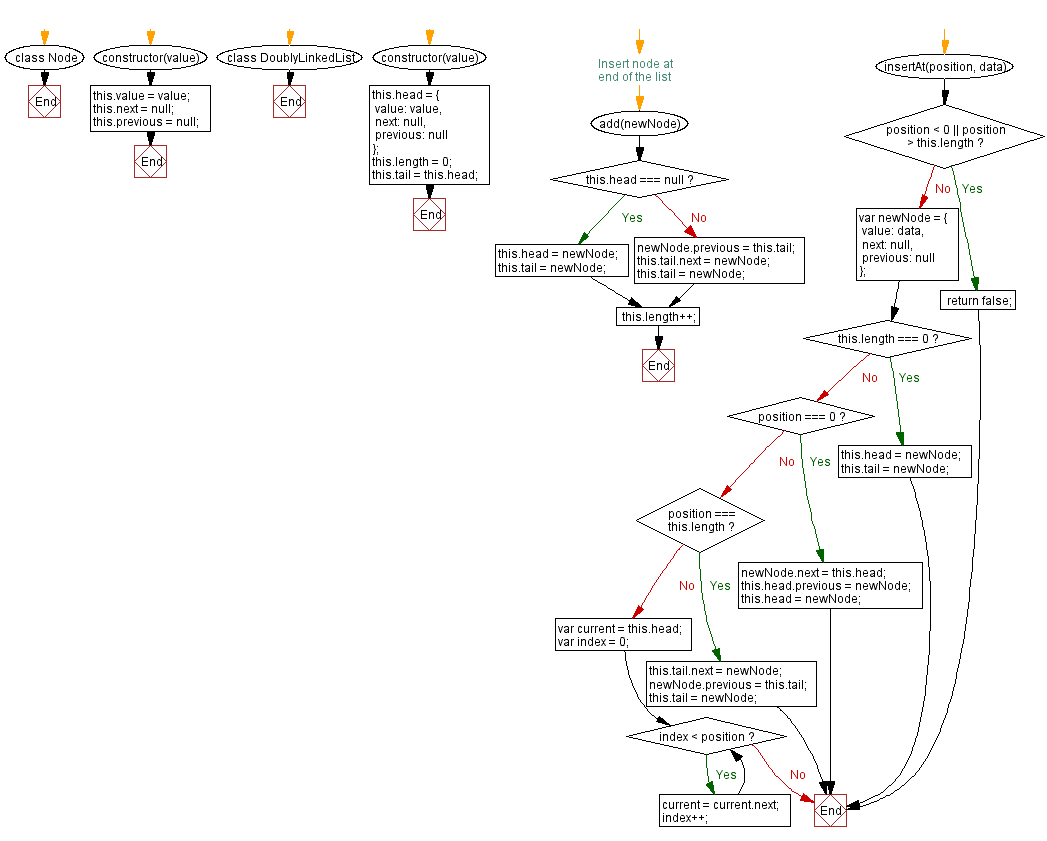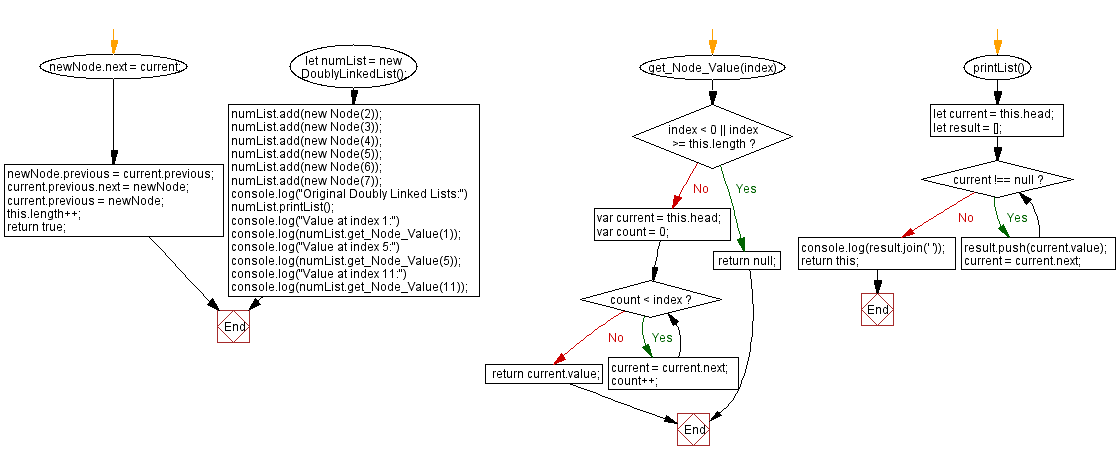JavaScript Exercises: Get the value of a node at a given position in a Doubly Linked List
JavaScript Data Structures: Exercise-8 with Solution
Get the value of a node at a given position in a DLL
Write a JavaScript program to get the value of a node at a given position in a Doubly Linked List.
Sample Solution:
JavaScript Code:
// Define a class for creating nodes of a doubly linked list
class Node {
constructor(value) {
this.value = value; // Store the value of the node
this.next = null; // Pointer to the next node in the list, initially set to null
this.previous = null; // Pointer to the previous node in the list, initially set to null
}
}
// Define a class for creating a doubly linked list
class DoublyLinkedList {
constructor(value) {
// Initialize the head node with the given value and no next or previous node
this.head = {
value: value, // Store the value of the head node
next: null, // Pointer to the next node in the list, initially set to null
previous: null // Pointer to the previous node in the list, initially set to null
};
this.length = 0; // Initialize the length of the list to 0
this.tail = this.head; // Set the tail node to the head node initially
}
// Method to add a new node at the end of the list
add(newNode) {
// Check if the head is null, indicating an empty list
if (this.head === null) {
this.head = newNode; // Set the head to the new node
this.tail = newNode; // Set the tail to the new node
}
else
{
newNode.previous = this.tail; // Set the previous pointer of the new node to the current tail
this.tail.next = newNode; // Set the next pointer of the current tail to the new node
this.tail = newNode; // Update the tail to the new node
}
this.length++; // Increment the length of the list
}
// Method to insert a new node at a specified position in the list
insertAt(position, data) {
if (position < 0 || position > this.length) {
return false; // Return false if the position is invalid
}
var newNode = { // Create a new node with the given data
value: data,
next: null,
previous: null
};
if (this.length === 0) { // If the list is empty, set the head and tail to the new node
this.head = newNode;
this.tail = newNode;
} else if (position === 0) { // If inserting at the beginning, update the head
newNode.next = this.head;
this.head.previous = newNode;
this.head = newNode;
} else if (position === this.length) { // If inserting at the end, update the tail
this.tail.next = newNode;
newNode.previous = this.tail;
this.tail = newNode;
} else { // Otherwise, find the position and insert the new node
var current = this.head;
var index = 0;
while (index < position) {
current = current.next;
index++;
}
newNode.next = current;
newNode.previous = current.previous;
current.previous.next = newNode;
current.previous = newNode;
}
this.length++; // Increment the length of the list
return true; // Return true to indicate successful insertion
}
// Method to get the value of a node at a specified index
get_Node_Value(index) {
if (index < 0 || index >= this.length) {
return null; // Return null if the index is out of bounds
}
var current = this.head; // Start from the head of the list
var count = 0;
while (count < index) { // Iterate through the list until reaching the specified index
current = current.next;
count++;
}
return current.value; // Return the value of the node at the specified index
}
// Method to print the values of the nodes in the list
printList() {
let current = this.head; // Start from the head of the list
let result = []; // Array to store the values of the nodes
while (current !== null) { // Iterate through the list until reaching the end
result.push(current.value); // Push the value of the current node to the array
current = current.next; // Move to the next node
}
console.log(result.join(' ')); // Log the values of the nodes separated by space
return this; // Return the DoublyLinkedList object for chaining
}
}
// Create a new instance of the DoublyLinkedList class
let numList = new DoublyLinkedList();
// Add nodes to the list
numList.add(new Node(2));
numList.add(new Node(3));
numList.add(new Node(4));
numList.add(new Node(5));
numList.add(new Node(6));
numList.add(new Node(7));
// Display the original doubly linked list
console.log("Original Doubly Linked List:");
numList.printList();
// Display the value of the node at index 1
console.log("Value at index 1:");
console.log(numList.get_Node_Value(1));
// Display the value of the node at index 5
console.log("Value at index 5:");
console.log(numList.get_Node_Value(5));
// Display the value of the node at index 11 (out of bounds)
console.log("Value at index 11:");
console.log(numList.get_Node_Value(11));
Output:
"Original Doubly Linked Lists:" " 2 3 4 5 6 7" "Value at index 1:" 2 "Value at index 5:" 6 "Value at index 11:" null
Flowchart:


Live Demo:
See the Pen javascript-doubly-linked-list-exercise-8 by w3resource (@w3resource) on CodePen.
For more Practice: Solve these Related Problems:
- Write a JavaScript function that traverses a DLL to return the value of the node at a specified index.
- Write a JavaScript function that uses recursion to locate and return the data of a node at a given position in a DLL.
- Write a JavaScript function that validates the provided index and returns a default value if the index is out of range.
- Write a JavaScript function that iterates from the head of a DLL and returns the node’s value when a counter matches the desired index.
Go to:
PREV : Insert a new node at the end of a DLL.
NEXT : Create a DLL of n nodes and display in reverse.
Improve this sample solution and post your code through Disqus
What is the difficulty level of this exercise?
Test your Programming skills with w3resource's quiz.
